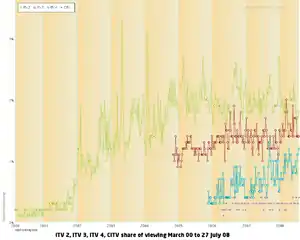Barb Audiences
Barb Audiences Ltd (formerly Broadcasters Audience Research Board) is a British organisation that compiles audience measurement and television ratings in the United Kingdom. It was created in 1981 to replace two previous systems whereby ITV ratings were compiled by JICTAR (Joint Industry Committee for Television Audience Research), whilst the BBC did their own audience research.
| Founded | 1981 |
|---|---|
| Type | Television ratings, audience measurement |
| Location | |
| Website | barb |
BARB is jointly owned by the BBC, ITV, Channel 4, Channel 5, Sky and the Institute of Practitioners in Advertising. Participating viewers have a box on top of their TV sets which tracks the programmes they watch.
In February 2023, Barb changed its company name to Barb Audiences Ltd (formerly Broadcasters' Audience Research Board).[1]
Business

Currently, BARB have approximately 5,100 homes (equating to approximately 12,000 individuals)[2] participating in the panel. This means that with a total UK population of 65,648,100, according to the 2016 census,[3] each viewer with a BARB reporting box represents over 5,000 people. The box records exactly what programmes they watch, and the panelists indicate who is in the room watching by pressing a button on a remote control handset. The data is collected overnight and published as overnight ratings at around 9.30 the following morning for use by TV stations and the advertising industry. The following week, final figures are released which are a combination of the overnight figures with "time-shift" figures (people recording a programme and watching it within a week). For programmes from December 15, 2014, onwards, BARB has begun publishing viewing figures for a period of 28 days after the original broadcast.[4]
BARB numbers are extremely important to commercial television stations. The trading model that is used by television companies and advertising agencies depends on the number of people watching the shows, and the commercial attractiveness of those people. The advertising agency will pay the television station a certain amount of money based on the number of people watching a show. The BARB numbers are used to work this out. Higher BARB numbers usually mean more advertising revenue for the television station.
This leads to some interesting situations on the smaller channels. Since there are many television stations, and many hours in the day, there can be situations where BARB will record zero viewers for certain programmes. As the TV advertising system is geared round BARB ratings all but the very smallest channels subscribe to BARB.
The BARB publishes inter alia Weekly Top 10 Charts,[5] a Weekly Viewing Summary for programmes[6] or the use of programme genres.[7]
Data gathering
BARB's 2010 research contracts were awarded to three different market research companies: RSMB, Ipsos MORI, and Kantar Media. The contracts ran from January 2010 to the end of 2015, with an option to extend further.
RSMB are responsible for survey design, quality control and calculation methodology. Ipsos MORI's role is to survey the characteristics of the television owning population, including an element of direct recruitment to the viewing panel. Kantar Media is responsible for establishing and maintaining the new BARB viewing panel. It has a separate contract covering meter panel installation, data retrieval, processing and audience reporting functions.[8]
See also
References
- "Barb to expand audience measurement to incl. fit-for-TV content on video-sharing platforms | Barb". Retrieved 21 February 2023.
- "How we do what we do". BARB. Retrieved 7 January 2016.
- "United Kingdom population mid-year estimate 2016". The Office for National Statistics. 22 June 2017. Retrieved 15 September 2017.
- Lewis, Joe. "I wish it could be Christmas every day". BARB. Archived from the original on 19 February 2015. Retrieved 19 February 2015.
- BARB. "TOP 10 Programmes - BARB". BARB. Retrieved 14 January 2016.
- BARB. "Weekly Viewing Summary - BARB". BARB. Retrieved 14 January 2016.
- BARB. "Weekly Viewing by Genre - BARB". BARB. Archived from the original on 11 January 2016. Retrieved 14 January 2016.
- "Frequently asked questions". BARB. Archived from the original on 19 June 2013.